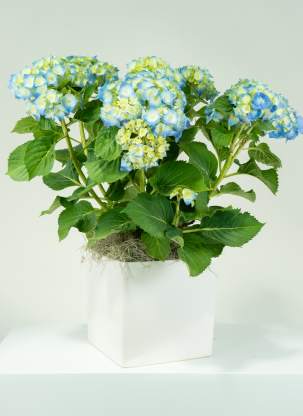Caring for Hydrangea Plants Indoors: Tips for Long-lasting Beauty
Easter hydrangea plants bring a burst of vibrant color and charm to indoor spaces, making them a popular choice for Easter and springtime decorations. However, to ensure your hydrangea thrives and maintains its beauty indoors, it's essential to provide the right care and conditions. In this guide, we'll explore tips for caring for hydrangea plants indoors, helping you enjoy their stunning blooms for weeks to come.
1. Optimal Lighting Conditions:
Hydrangeas prefer bright, indirect light when grown indoors. Place your plant near a north or east-facing window where it can receive plenty of natural light without being exposed to direct sunlight, which can scorch the delicate blooms and foliage. If natural light is limited, supplement with artificial grow lights to ensure adequate illumination.
2. Proper Watering Routine:
Maintaining the right moisture level is crucial for the health and longevity of hydrangea plants. Water your hydrangea thoroughly when the top inch of soil feels dry to the touch, ensuring that excess water drains freely from the bottom of the pot. Avoid overwatering, as waterlogged soil can lead to root rot and other moisture-related issues.
3. Humidity Management:
Hydrangeas thrive in environments with high humidity levels, making them well-suited for bathrooms or kitchens with naturally humid conditions. To increase humidity around your hydrangea plant, place a shallow tray filled with water and pebbles beneath the pot or use a room humidifier. Misting the leaves with water periodically can also help maintain humidity levels.
4. Temperature Considerations:
Hydrangeas prefer temperatures ranging from 60 to 70°F (15 to 21°C) during the day and slightly cooler temperatures at night. Avoid placing your plant near drafts, heating vents, or air conditioning units, as sudden temperature fluctuations can stress the plant and affect blooming.
5. Pruning and Deadheading:
Regular pruning and deadheading can help promote healthy growth and prolong the blooming period of your hydrangea plant. Remove spent blooms and wilted flowers as soon as they fade to encourage the development of new buds. Use clean, sharp pruning shears to make precise cuts just above a set of healthy leaves or buds.
6. Fertilization:
Fertilize your hydrangea plant regularly during the growing season to provide essential nutrients for robust growth and abundant flowering. Use a balanced, water-soluble fertilizer formulated for flowering plants and apply it according to the manufacturer's instructions. Avoid over-fertilizing, as excessive nutrients can lead to leaf burn and diminished blooming. We recommend a liquid form for better application and absorption.
7. Pest and Disease Control:
Keep an eye out for common pests such as aphids, spider mites, and whiteflies, which can infest Easter hydrangea plants indoors. Inspect the leaves and stems regularly for signs of pest activity, such as sticky residue, distorted growth, or yellowing foliage. Treat any pest infestations promptly with insecticidal soap or neem oil, following the product label instructions.
With proper care and attention to its needs, an Easter hydrangea plant can grace your indoor space with its exquisite blooms for weeks or even months. By providing optimal lighting, watering, humidity, temperature, pruning, fertilization, and pest control, you can ensure that your Easter hydrangea thrives and remains a stunning focal point in your home throughout the spring season and beyond.



